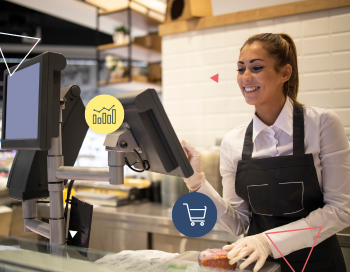The era of waiting for hours in an ER, walk-in clinic or urgent care center is over. Healthcare providers in these settings know it’s important to help low-acuity patients easily check in and slash time spent in the waiting rooms.
Thanks to companies like ER Express, acute care providers can make all of this happen in the cloud.
Atlanta-based ER Express has spent the last eight years perfecting two compatible technology solutions, Check-In Express and Walk-In Express, to reshape how urgent care facilities manage patient loads and deliver a better overall patient experience — with less clinic waiting room stress.
The company began by offering cloud-based check-in software for walk-in, acute-care facilities, allowing their patients without life-threatening health issues to reserve a spot in line for treatment.
With Check-In Express, patients can go to the health care facility’s website, select a preferred time and location for their visit, and wait in the comfort of their home until their designated arrival time.
“It’s not an appointment system,” explains Clark Dixon, Director of Customer Experience at ER Express. “You can’t book weeks or even days in advance, but you can reserve a place in line for the same or next day. You could check in online on the way home from work, stop at the urgent care center, and when you get there, they’re ready for you.”
That’s the first part of what ER Express provides to improve patient experience outcomes in the acute care space. As competition grew, the company knew it needed to take the next step, addressing the needs of walk-in patients checking in on site. They also realized that the facility’s staff needed a way to track both online and walk-in patients in one place.
“We wanted to move into a true queuing solution to help the providers view all of the patients in the ‘lobby’ whether they are waiting at home or on-site,” Dixon says. “And we wanted to provide them with a way to ease patient anxiety about waiting for treatment.”
This is where Google Chrome Enterprise and Onix join the story.
Easy Patient Management
Running on Chrome OS, Walk-In Express uses Acer R11 Chromebooks or Chromebase-Mini tablets to allow patients to sign in at a clinic. Every patient that walks in must go to a kiosk with a touchscreen tablet or a laptop to sign in and indicate they are physically in the clinic’s waiting room.
“Basically, we digitized the old-school registration clipboard using a combination of the Chrome Enterprise and our proprietary app,” says Dixon. “The system is often plugged into electronic health records. We get the necessary metrics from every patient, which helps us accurately predict treatment times when they check-in. Our goal is to decrease patient anxiety that comes with waiting.”
Chrome is an incredibly powerful OS designed specifically for the cloud. While many people use it individually on the consumer side, Google Chrome Enterprise gives organizations the benefits of Chrome OS — speed, simplicity and security — across all business areas.
Google Chrome offers a comprehensive, endpoint solution providing easy central management that boosts productivity and improves collaboration, all promoting a definitive return on investment.
Most major manufacturers have developed laptop-style Chromebooks or all-in-one Chromebases running exclusively on the Chrome OS to provide a faster, more secure and easier to manage cloud computing experience.
In a further effort to reduce patient anxiety, clinics using the ER Express solution have also installed large monitors in waiting areas that display patient queue status, similar to those at an airport gate. Patients receive a three-letter ID code so they can track their wait times.
ER Express uses a custom-built kiosk Chrome app designed by Matt Cook at The Cook Company in Madison, Wisconsin. A Chromebit plugged into the monitor helps make this happen. Chromebits are the smallest Chrome OS devices. These HDMI sticks turn any screen with an HDMI port into a computer. As with all Chrome Enterprise hardware, users will enjoy effortless setup and secure computing with a Chromebit.
Chromebits are the smallest Chrome OS devices. These HDMI sticks turn any screen with an HDMI port into a computer. As with all Chrome Enterprise hardware, users will enjoy effortless setup and secure computing with a Chromebit.
“These Google Chrome solutions make it easy for users to enroll devices for the first time, manage them on the back end and push out their digital signage solutions,” says Josh Ramsey, Onix Chrome Sales Specialist.
Dixon agrees, noting that setup out of the box is fast and simple, both for the kiosks and the digital monitors. He also says they couldn’t find other solutions that do what the custom kiosk app — combined with Chromebit — do together to allow ER Express customers to customize in-lobby digital signage.
“The custom kiosk software from The Cook Company works well with Chrome,” Dixon relates, adding that this technology has really helped to keep patients informed about their wait times.
ER Express also uses its internal web app with the Chromebit to allow customers to provide on-screen advertising on the in-lobby monitor. For example, they could partner with a local pharmacy to advertise flu shots or weekly specials. They might also include their own pages with preventive health care marketing. All of these can be slotted in between wait-time updates, adding value to the digital signage solution.
Simplified Support
Chrome wasn’t the first product ER Express tried, but it’s likely the last.
“When we first launched the product, our first customer was on an Apple platform, so we used iPads, but we quickly learned that Chrome devices were more cost-effective,” he recalls. “We tested them and learned they were also easy to use with our proprietary app.”
Because ER Express manages its customers’ support and service needs, Dixon realized that having a single platform makes things easier on the back end. He said they had discussed working with an open-device policy, but decided instead to mandate Chrome. If a customer wants to use ER Express products, there must be a willingness to use the Chrome OS and devices.
When a sign-in kiosk isn’t working, it’s easy for ER Express techs to identify a solution since the platform is either a Chromebook or a Chromebase-Mini. They can quickly run diagnostics to make decisions and effect repairs. Focusing on the Google Chrome platform is key to achieving success with support, and a reason why the company wants to continue working with Chrome into the future.
“We’re a very high-touch organization with our end users and we field a lot of support requests so it is important for us to keep everything standardized,” Dixon explains. “An open-device policy would take up so much support time for our crew to work with devices not related to us. We can offer faster, better support with Chrome because that’s what we know and use.”






